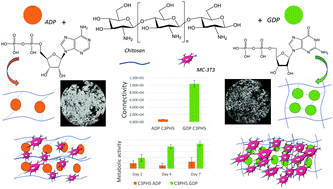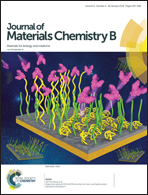The bioconjugation mechanism of purine cross-linkers affects microstructure and cell response to ultra rapidly gelling purine–chitosan sponges†
Abstract
As a cell carrier, cross-linking is one of the most common approaches used to provide chitosan with greater structural integrity. We introduced a cross-linking strategy by using two purines, guanosine 5′-diphosphate (GDP) or adenosine 5′-diphosphate (ADP), as cross-linkers. The rationale for this approach is that both GDP and ADP have an important physiological role and act as intercellular signaling molecules in numerous biological processes. The slight difference between the chemical structure of guanine and adenosine in GDP and ADP, respectively, affect the cross-linking mechanism. This resulted in a different scaffold microstructure and thus, altered the response of encapsulated cells to the scaffold. FTIR and solid-state 13C-NMR revealed the formation of a quadruplex structure among the four GDP molecules confined between the chitosan backbone. This resulted from the ability of guanine to form intermolecular hydrogen bonds, while adenosine in ADP lacks this capacity. The formation of a more organized structure in GDP-chitosan sponges also increased the crystallinity of the sponge as shown by X-ray diffraction data. Further, physicochemical analyses with SEM and μCT indicated a more open-pore architecture and increased porosity. Although an active population of encapsulated cells was maintained in all chitosan sponges overtime, the GDP-based sponges provided a 6-fold increase in the activity of MC-3T3 cells and significantly enhanced their proliferation due to a more appropriate microstructure. Overall, these findings suggest that slight changes in the chemical structure of the cross-linker in the preparation of chitosan-based biomaterials will have a significant impact on the structural properties of the chitosan. This important parameter can be utilized to modulate cell response and to understand the cell signaling pathway of chitosan-based biomaterials in the context of their applications in tissue engineering.



 Please wait while we load your content...
Please wait while we load your content...